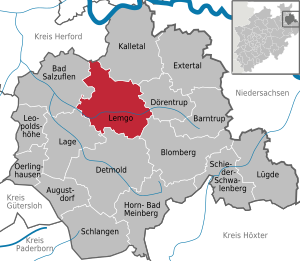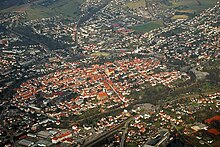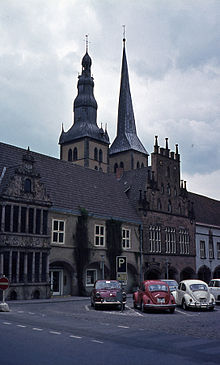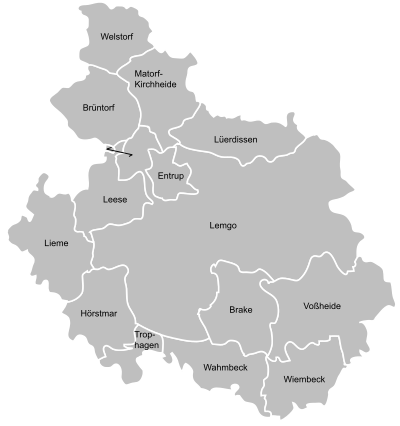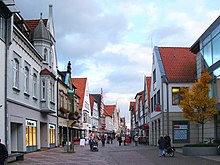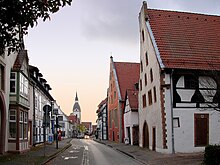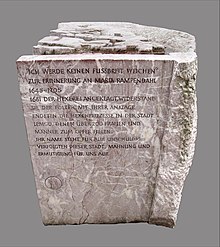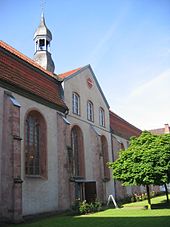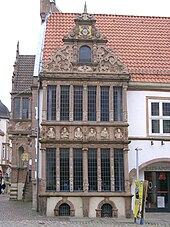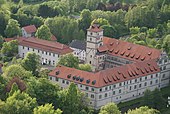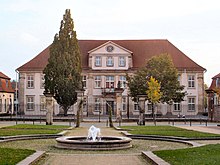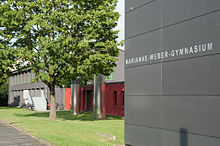Lemgo
| coat of arms | Germany map | |
|---|---|---|

|
Coordinates: 52 ° 2 ′ N , 8 ° 55 ′ E |
|
| Basic data | ||
| State : | North Rhine-Westphalia | |
| Administrative region : | Detmold | |
| Circle : | lip | |
| Height : | 100 m above sea level NHN | |
| Area : | 100.85 km 2 | |
| Residents: | 40,619 (Dec. 31, 2019) | |
| Population density : | 403 inhabitants per km 2 | |
| Postal code : | 32657 | |
| Primaries : | 05261, 05266 | |
| License plate : | LIP | |
| Community key : | 05 7 66 044 | |
| LOCODE : | DE LEM | |
| City structure: | 14 districts | |
City administration address : |
Marktplatz 1 32657 Lemgo |
|
| Website : | ||
| Mayor : | Reiner Austermann ( CDU ) | |
| Location of the city of Lemgo in the Lippe district | ||
Lemgo [ ˈlɛmgoː ] ( Low German : Lemge, Lemje ) is a university town with about 43,000 inhabitants. It is the third largest city in the Lippe district and is 25 kilometers east of Bielefeld in the middle of the Ostwestfalen-Lippe region . The city belongs to the administrative district of Detmold in the northeast of North Rhine-Westphalia .
Lemgo was founded in 1190 at a crossing point of important trade routes as a planned town by the Lords of Lippe . This makes the place next to Lippstadt, which is now in the Soest district , one of the oldest cities in Lippe . Lemgo has had city rights since 1245, was a member of the Hanseatic League in the late Middle Ages and is therefore also called the Old Hanseatic City of Lemgo . The cityscape is characterized by numerous late medieval buildings. Until 1973, Lemgo was the seat of the administration of the Lemgo district , which was opened up in the Lippe district as part of a district reform.
Lemgo is the seat of the Technical University Ostwestfalen-Lippe (TH OWL) and with the Innovation Campus Lemgo has developed into one of the three regional centers of excellence in the technology network Intelligent Technical Systems Ostwestfalen-Lippe . The place is known nationally for the success of the Bundesliga handball team of TBV Lemgo . The city is characterized by the rural surroundings of the Lipper Bergland , the largest branches of business are metal processing, the manufacture of dental instruments, mechanical engineering, industrial electronics and the service sector.
On the occasion of the 500th anniversary of the Reformation , Lemgo was awarded the honorary title of “ Reformation City of Europe ” by the Community of Evangelical Churches in Europe in 2016 as the 52nd city out of 100 cities in 17 countries .
geography
Geographical location
Lemgo is located in the Bega valley in the hilly Lipper Bergland , a low mountain range in the north of the Lippe district , in the northeast of the state of North Rhine-Westphalia . The area on the northern edge of the low mountain range threshold is bounded in the north by the Wiehengebirge , in the south by the Teutoburg Forest and in the east by the Weser and naturally belongs to the Weser Uplands . Although the city was founded in the valley, it stretches up to the surrounding heights of the mountains and has occupied a large area in the Lipper Bergland at the latest since the incorporation. The deepest point is 83 m in the Bega valley on the border with Bad Salzuflen in the Lieme district . The highest point in the urban area is the Windelstein at 347 m above sea level. NN in the Lemgoer Mark east of the city center.
The next larger cities are in the north Minden (29 km away), in the west Bielefeld (25 km) and in the south Detmold (12 km) and Paderborn (36 km). The surrounding region of Lippe belongs to the Ostwestfalen-Lippe region .
Lemgo's old town lies on the north bank of the Bega, a right tributary of the Werre, which flows here from east to west .
geology

The city lies in the Lemgo valley basin, a lowland drained by the Bega . This depression was filled in during the Ice Age by a ground moraine and then by river deposits. The surface is covered with loess . Among them are layers of marl clay , limestone and sandstone (especially Planicosta sandstone ) from the Middle Ages. In the course of the earth's history, these sedimentary rocks were lifted out and form saddles, hollows, clumps and trenches. In the subsurface, the rock layers are arranged side by side. Rock salt and gypsum are dissolved in the deep subsoil, so that funnel-shaped depressions could be found there.
Lemgo's urban area is particularly suitable in the north-west and south-west parts of the municipality, otherwise it is largely suitable for the use of geothermal heat sources by means of geothermal probes and heat recovery through heat pump heating . Only a few locations are not suitable (see the geothermal map of Lemgo ).
Expansion and use of the urban area
Lemgo is located in the rural Lipperland; Most of the urban area is used for agriculture , followed by forest use . Settlement and traffic areas take up around 20%.
With incorporations, the urban area extends to around 101 km². In the north-south direction Lemgo extends a maximum of 14.3 km, in the east-west direction a maximum of 13.1 km.
The land use can be found in the following table:
| Area according to type of use | Area in ha | Share of total area |
|---|---|---|
| Agricultural area | 5638 | 55.9% |
| Forest area | 2253 | 22.3% |
| Settlement and traffic areas | 2098 | 20.8% |
| Water surface | 79 | 0.8% |
| other use | 17th | 0.2% |
As of December 31, 2013
Neighboring communities
Lemgo is relatively centrally located in the Lippe district and borders clockwise, starting in the north, with the cities and communities of Kalletal , Dörentrup , Blomberg , Detmold , Lage , Bad Salzuflen (all Lippe district ) and Vlotho ( Herford district ).
City structure
Since the municipal reform in the Lemgo district on January 1, 1969, the city has been divided into 14 districts, which are listed in the following table together with the number of inhabitants (main and secondary residences). At the end of 2016, 1,420 people were registered with secondary residence in Lemgo.
| Districts and population with main or secondary residence | |||||
|---|---|---|---|---|---|
| Districts | Resident December 31, 2004 |
Resident December 31, 2006 |
Resident December 31, 2010 |
Resident December 31, 2016 |
Districts of Lemgo |
| Lemgo | 27,326 | 27,699 | 27,433 | 27,182 | |
| Brake | 5616 | 5203 | 5028 | 4971 | |
| Broth peat | 737 | 711 | 717 | 664 | |
| Entrup | 1041 | 1000 | 1020 | 967 | |
| Hörstmar | 1481 | 1482 | 1433 | 1422 | |
| Leese | 632 | 651 | 671 | 629 | |
| Lieme | 2787 | 2827 | 2708 | 2631 | |
| Lüerdissen | 726 | 731 | 759 | 731 | |
| Matorf-Kirchheide | 1492 | 1508 | 1539 | 1506 | |
| Trophages | 203 | 194 | 205 | 186 | |
| Vossheide | 1286 | 1280 | 1308 | 1175 | |
| Wahmbeck | 910 | 887 | 879 | 863 | |
| Welstorf | 207 | 196 | 205 | 177 | |
| Wiembeck | 225 | 217 | 210 | 167 | |
climate
Lemgo, like the whole of the Lippe Uplands , lies in the transition area between the predominantly prevailing maritime climate and the weaker continental climate that is only temporarily pronounced in this area . Therefore, the temperatures and rainfall are relatively balanced during the year. The summers are rather cool compared to the highly continental climate, the winters are rather warm. The city is located in the Atlantic climate area, has 799 mm of precipitation and is relatively balanced in terms of temperatures. The Teutoburg Forest shields the place from the prevailing winds from the west, which bring precipitation from the Atlantic . The annual average temperature is around 8.5 ° C to 9 ° C.
history
City foundation and the late Middle Ages
The first documented settlement was in 2008 through the determination of the age of a small piece of bone of a buried east-west direction corpse on the former cemetery of the original St. John Church on what is today called stumps tower at the time of the Saxon wars under Charlemagne to can be dated to the year 780. The area in which today's city of Lemgo is located was called Limgauwe or Limga at the beginning of the 11th century . The settlement history, as evidenced by documents, shows that there were several settlements there in the 11th and 12th centuries. The Castle Brake has already been built before 1190, but was in a marshy flood plain of Bega that no suitable premises provided for the establishment of a city.
Lemgo was founded by Bernhard II in 1190 to the north-west of it in a dry area and, thanks to its location at the crossroads of two important trading routes in the Middle Ages, developed into the largest and most important town in the County of Lippe for a long time . In 1215 the parish church of St. Nicolai was consecrated.
In 1231 the diocese of Paderborn elevated the city to the seat of the archdeacon , the episcopal deputy, around 1235 the Civitas , which now had its own seal, minted coins. After Lemgo had acquired town charter in 1245 and the wall tailor privilege granted the trade privileges, the town applied for membership in the Hanseatic League in 1295 . But it was not accepted as a Hanseatic city until 1324 . Lemgo then linked up with the cities of Herford and Bielefeld in the so-called Cologne quarter to trade in cloth, yarn and linen . The trade relations of the Lemgo merchants led via Lübeck to Visby , Stockholm and Turku in Scandinavia and via Bremen and Elberfeld (now part of Wuppertal ) to Flanders , and Lemgo gained noticeably in economic importance. Together with Lippstadt , it was also able to influence the politics of the count. The city also secured control of the financial administration. In addition, the city played a certain role in peace alliances, especially to secure long-distance trade, and in the first half of the 15th century it also took part in day trips of the Hanseatic League. It is possible that the city already had 3500 inhabitants around 1300.
Similar to Lippstadt, Lemgo was laid out according to a three-street scheme and had to be expanded to include the new town as early as 1265 due to its economic success. This was south of the old town in the damp Begaaue and was laid out in a two-street system. Initially independent - nobleman Simon I granted it city rights - the more artisanal Neustadt was separated from the old town by markings before both districts were united in 1365 and secured with a shared moat and rampart. The road system was created from five streets running in an east-west direction, which are connected by a north-south axis. This is considered to be unique in the entire Lippe and East Westphalia area .
Reformation and witch hunt
The prosperity of the city at this time is evident in the richly decorated stone gable and half-timbered buildings that can be found in the entire city center, primarily on the market square and on Mittelstrasse. The economic upswing led to a pronounced self-confidence of the citizens, which was also expressed towards the church and the sovereign. Before the county of Lippe converted to the evangelical confession in 1538, a Reformation movement formed in Lemgo in the 1520s, which in 1533 achieved the introduction of the Reformation in the city. In 1605 Count Simon VI. officially to the Evangelical Reformed creed, so that in Lippe the change from the Lutheran to the Reformed creed was carried out according to the principle cuius regio, eius religio . After years of disputes, the Röhrentruper Rezess in 1617 allowed the city to stick to the Lutheran creed.
A severe economic crisis, triggered by the Thirty Years War (1618–1648), with plague epidemics, billeting and contribution payments , brought poverty and misery to the city and made it an insignificant agricultural town .
One of the most beautiful town houses, with a richly decorated Renaissance gable, is the Krüwelhaus on the lower Breiten Straße. This building is better known under the name Hexenbürgermeisterhaus and is a reminder of the darkest time in Lemgo's history. Mayor Hermann Cothmann (1629–1683), who played a leading role in the witch hunt, lived here in the 17th century . The aftermath of the Thirty Years War and the plague epidemics led to the witch trials , in which numerous innocent women and men were charged with sorcery . It was practically impossible to defend oneself against this accusation, because under the torture , called Embarrassing Questioning , a confession was forced from everyone. Then the delinquents convicted of witchcraft were burned at the stake . By 1681, 272 men and women in Lemgo alone, including Pastor Andreas Koch, lost their lives in this way . This gave the city in Lippe a special position and was given the nickname Lemgo, the witches' nest . The last person charged in a witch trial in 1681 was Maria Rampendahl . She resisted the torture and survived but was forced to leave the city and the country. There is a museum in the witch mayor's house, in which replicas of the instruments of torture used at the time were exhibited until a few years ago. The corresponding witch trial files and other documents on the city's history can be viewed in the Lemgo City Archives .
On June 18, 2012, the Lemgo City Council confirmed that the victims of the witch trials had been rehabilitated in Lemgo through the council resolution to erect the “Stumbling Block” (monument to Maria Rampendahl - see photo) on January 20, 1992 in Lemgo.
Modern times and industrialization
The arable town and craftsman town could no longer build on the economic success of the Hanseatic era. In the meantime, Detmold had developed into a residential city, which soon surpassed Lemgo in importance and population. Linen weaving and trading were no longer important, and other branches of industry, such as the construction of carriages and horse-drawn wagons, the manufacture of meerschaum pipes and the tobacco industry could not set economic trends. In 1664 the brothers Albert and Heinrich Meyer founded a printing house, which later became the Meyersche Hofbuchhandlung . Engelbert Kaempfer's travelogues about Persia , India and Japan were particularly successful in the 18th century . This success in printing and publishing helped the city to gain the nickname Westphalian Leipzig .
Engelbert Kaempfer (1651–1712), after whom a grammar school in Lemgo is named, is one of the city's most important sons. From 1682 he was one of the first German explorers to explore Persia, India, Java and finally Japan, whose culture, fauna and flora he described as the first European.
Lemgo was the center of the Lippe linen trade until the 16th century, but was replaced in this role by Bielefeld and Osnabrück . It was not until the middle of the 18th century that the Kracht merchant family from Lemgo turned back to the linen trade until they finally established one of two linen factories in Lemgo in 1887/88.
With the connection to the railway network in 1896, the city expanded further. Residential houses and businesses were built outside the ramparts. The western part of the rampart was removed and a wide street led directly to the train station in the south of the city. In the following decades, the first furniture factories developed out of handicraft businesses, and the furniture industry was the dominant branch of industry until the period after the Second World War .
Period of National Socialism and World War II
As everywhere in Germany, social democrats and other uncomfortable citizens were also forced out of public office in Lemgo . The NSDAP installed a new city council, but mayor Wilhelm Graeffer (1885–1945) was allowed to remain in office. The tailor Willy Langenberg was a member of the KPD and actively resisted the Nazis. For political offenses he had to serve a prison sentence from 1934 to 1939 and was under the surveillance of the Gestapo after his release . In 1941, he went into hiding and committed in March 1944 after a firefight with police in a hopeless situation suicide .
The Lemgo synagogue was set on fire on the night of the Reichspogromnacht in 1938 , the photo studio of the Jew Erich Katzenstein was destroyed, window panes were smashed in the apartments of Mathilde Lenzberg and the Jewish Frenkel family, and a door of the Davidsohn family was broken into. "The heavy iron gates of the Jewish cemetery were secured by order of the mayor" ( Wilhelm Graefer ). The old Jewish cemetery was "razed", " in the night of November 9-10, 1938, seven monuments were knocked over in the new Jewish cemetery ." Of the 65 so-called full Jews living in Lemgo in 1933, the last 22 were killed on July 28, 1942 Brought to Bielefeld by car and deported from there to Theresienstadt concentration camp . So did Emilie Davidsohn, Erich Katzenstein, Mathilde Lenzberg, Karla Raveh and Adolf Sternheim . Only three of the deportees survived the Holocaust . The memorial book of the Federal Archives for the Victims of the National Socialist Persecution of the Jews in Germany (1933–1945) lists 38 Jewish residents of Lemgo who were deported and mostly murdered .
The city survived the Second World War almost unscathed until the spring of 1945. On April 3, 1945, the 2nd US Armored Division approached from the south . At this time, the Bleidorn barracks (later Spiegelberg barracks ) briefly housed the command post of General Paul Goerbig and the subordinate combat commander of Lemgo, Captain Walter Heckmann . At Rieper Berg and Hörstmar , anti-tank barriers were prepared against the approaching US tanks. Lemgo should be defended to the last man. The manufacturer Lüpke and Mayor Wilhelm Graefer wanted to negotiate a handover of the city with the US troops under Lieutenant Colonel Hugh R. O'Farrell near Hörstmar. On their return both were arrested by Captain Heckmann. Lüpke was able to escape during a transport trip, Mayor Gräfer was brought before a court martial in Lügde on April 4, sentenced to death by General Goerbig and executed the following morning in Bodenwerder by SS soldiers on the market square. The western part of Lemgo came under fire and 27 German soldiers were killed in the urban area that was captured by US troops on the evening of April 4, 1945. Between Lemgo and Groß-Berkel , 603 Wehrmacht soldiers were taken prisoners of war.
Development 1945–1970
Lemgo came to the British occupation zone after the end of the war and was subordinate to the Commander Harwey, who was the District Administrator a. D. Clemens Becker appointed mayor of the city.
From April 1945 the British Rhine Army (BAOR) maintained the Stornoway Barracks, the former lead thorn barracks. On March 15, 1946, the British Control Commission ordered the establishment of the " German Labor and Housing Agency" based in Bad Oeynhausen, and in July 1946 the former President of the North Rhine Province Labor Office, Hermann Link, entrusted with setting up the office. When her superior office, the Manpower Division of the Control Commission for Germany (British Element), relocated to Lemgo, the advice center was moved there on July 12, 1946 and housed in the Stornoway Barracks. After the British military base was closed on August 24, 1993, the facilities were converted into modern residential buildings.
Around 1950 some companies in the electrical and lighting industry were founded, which developed into larger companies. This also applies to a constantly growing plant in the dental industry . The area in Grevenmarsch had long since become too small for the number of new businesses, and so large areas north of Lieme were designated as industrial areas. Only a few companies are left of the once dominant furniture industry.
After the war, the population of the city grew strongly, mainly through refugees and displaced persons from the former German eastern regions, and reached almost 20,000 inhabitants in 1949 compared to 13,489 in 1939. After the incorporation of 13 previously independent municipalities through the municipal reform, Lemgo counted on January 1, 1969 almost 38,000 inhabitants.
Development since 1970 and cityscape maintenance since 1920
Today's core city has developed together with Brake into a center for culture and economy in the last decades up to the beginning of the 21st century. With its late medieval cityscape, Lemgo is the destination of numerous tourists who visit the city every year. The Alt Lemgo association, which was founded on August 27, 1920, is responsible for maintaining and maintaining the old townscape . In the 1920s, under the direction of Karl Meier , the most important half-timbered facades, which were hidden under plaster, were uncovered for the first time. After the war, the maintenance of the townscape continued, and since 1920 more than 300 properties have been looked after, including advice and the acquisition and allocation of grants.
In the first two decades of the 21st century, Lemgos grew in importance as a science location. The Ostwestfalen-Lippe University of Applied Sciences (TH OWL) has developed into one of the ten most research-intensive universities for applied sciences through the establishment and development of various research institutes . The Innovation Campus Lemgo with its stakeholders forms a coherent science and education quarter and creates knowledge-based jobs in the region. As a non-university research institution, the Fraunhofer Institute is an important player here.
Incorporations
According to the law on the reorganization of the Lemgo district ( Lemgo law ) , the town of Lemgo and the communities of Brake in Lippe , Brüntorf , Entrup , Leese , Lieme , Lüerdissen , Matorf , Vossheide , Welstorf , Wiembeck and Wahmbeck became the new one on January 1, 1969 City of Lemgo merged. On January 1, 1970, the Detmold Law added the municipalities of Hörstmar and Trophagen from the Detmold district to the city of Lemgo. Since January 1, 1973, the city of Lemgo has been part of the new Lippe district , which unites the former Lemgo and Detmold districts.
Population development
The following overview shows the population of the city according to the respective territorial status, with some figures also according to the current territorial status. The figures are approximate before 1818, census results from 1818 to 1970 and for 1987, and from 1975 official updates from the State Office for Data Processing and Statistics and information from the Old Hanseatic City of Lemgo. The numbers 1975-1985 are estimated values, the numbers from 1990 extrapolations based on the results of the census of 1987. The figures relate since 1871 and for 1946 to the local attendees population, from 1925 to the resident population and from 1985 to the population at Location of the main residence . Before 1871, the population figures were determined using inconsistent survey methods.
|
|
|
|
Religions
As early as 1518, Luther's theses were read out from the pulpit by the later mayor Ernst von Wipper and others, and the town developed into a center of the Reformation alongside Lippstadt. In the following years, more and more citizens attended the Protestant church service and sang German instead of Latin hymns before and after the sermon. Although the Lippe sovereign Simon V rejected the Reformation, he could not intimidate the self-confident citizens of Lemgo. In 1537 the Braunschweig church order of the reformer Johannes Bugenhagen was officially adopted. Lippe turned in the 17th century under Simon VI. to Calvinism, which Lemgo openly opposed in a second Reformation. The city was able to prevail in court and remained Lutheran. In the so-called Röhrentruper Rezess the disputes between the largest city of Lippes and the sovereign were settled, but their citizens had to continue to recognize the rule of the Lippe counts.
For historical reasons, the majority of the present-day population of Lemgo belongs to the Lutheran "class" of the predominantly Evangelical-Reformed Lippe regional church . In Lemgo there are both Evangelical Lutheran and Evangelical Reformed church congregations. The two evangelical reformed parishes in Lemgo are St. Johann and St. Pauli . In addition, there are three Evangelical Lutheran parishes which, with the other Lutheran parishes of Lippe, form their own parish , called “Class” in Lippe, and also belong to the regional church: St. Nicolai , St. Marien and Eben-Ezer . All churches belong to the Lippe regional church , but are divided into the classes Lutheran and Brake (reformed).
The only Roman Catholic parish celebrates its services in the Holy Spirit Church . Together with four other parishes, it belongs to the Lemgo-Nordlippe pastoral association in the Bielefeld-Lippe dean's office in the Archdiocese of Paderborn .
For the Muslims in the urban area there is the Turkish Ahmet Yesevi Mosque, which belongs to the Turkish-Islamic Union of the Institute for Religion (DİTİB).
An indication of the distribution of religions can be the denomination of the Lemgo students. According to this, around 68% of the students are Protestant, 10% Catholic, 4% Islamic. 7% say they belong to another denomination, 11% do not belong to any denomination.
politics
City council
The Lemgo City Council consists of 46 council members. In addition, the mayor is the council chairman. The council is elected every five years. The next election will take place in 2020. The following table shows the local election results since 1975:
| 2014 | 2009 | 2004 | 1999 | 1994 | 1989 | 1984 | 1979 | 1975 | |||||||||||
|---|---|---|---|---|---|---|---|---|---|---|---|---|---|---|---|---|---|---|---|
| Political party | Seats | % | Seats | % | Seats | % | Seats | % | Seats | % | Seats | % | Seats | % | Seats | % | Seats | % | |
| CDU | 13 | 34.31 | 16 | 34.55 | 18th | 46.21 | 21st | 47.71 | 18th | 39.44 | 15th | 33.09 | 16 | 35.18 | 18th | 41.04 | 20th | 44.17 | |
| SPD | 12 | 30.37 | 13 | 28.36 | 15th | 36.31 | 17th | 39.05 | 21st | 44.63 | 24 | 50.79 | 23 | 50.54 | 23 | 50.75 | 22nd | 48.53 | |
| BfL 1 | 6th | 14.27 | 7th | 15.96 | - | - | - | - | - | - | - | - | - | - | - | - | - | - | |
| Green | 4th | 10.02 | 4th | 8.55 | 5 | 11.50 | 3 | 7.50 | 4th | 10.52 | 3 | 7.92 | 3 | 7.95 | - | - | - | - | |
| FDP | 2 | 5.00 | 4th | 7.82 | 2 | 5.98 | 3 | 5.75 | 2 | 5.41 | 3 | 8.20 | 3 | 6.34 | 4th | 8.21 | 3 | 7.27 | |
| left | 2 | 3.86 | 1 | 2.90 | - | - | - | - | - | - | - | - | - | - | - | - | - | - | |
| per NRW | - | - | 1 | 1.86 | - | - | - | - | - | - | - | - | - | - | - | - | - | - | |
| Pirates | 1 | 2.16 | - | - | - | - | - | - | - | - | - | - | - | - | - | - | - | - | |
| Others | - | - | - | - | - | - | - | - | - | - | - | - | - | - | 0 | 0.03 | |||
| Total 2 | 40 | 100 | 46 | 100 | 40 | 100 | 44 | 100 | 45 | 100 | 45 | 100 | 45 | 100 | 45 | 100 | 45 | 100 | |
| voter turnout | 53.15 | 57.66 | 59.30 | 61.33 | 82.36 | 70.44 | 73.61 | 76.94 | 88.15 | ||||||||||
1 Citizen for Lemgo (Free Voters)
2 without taking into account rounding differences
Since 2014 the 3 council members of the Left and the Pirate Party have formed the “Together for Lemgo” faction.
mayor
As is common in other municipalities, in Lemgo the offices of honorary mayor and full-time city director were separated until 1994. The first full-time mayor of Lemgo was Reinhard Wilmbusse.
- 1916–1920: Franz Möller
- 1921–1923: Karl Otto Floret
- 1923–1945: Wilhelm Gräfer
- 1945 Clemens Becker (SPD), retired chairman of the Lippe state presidium. D., District Administrator a. D.
- 1946–1947: Otto Drewes (CDU)
- 1947–1952: Johannes Kuhlmann (CDU)
- 1952–1954: Wolfgang Klasing (FDP)
- 1954–1956: Wilhelm Wippermann (FDP)
- 1956–1969: Wilhelm Wippermann (FDP), alternating with August Flohr (SPD)
- 1969–1971: Helmut Krüger (CDU)
- 1971–1999: Reinhard Wilmbusse (SPD)
- since 1999: Reiner Austermann (CDU)
coat of arms
| Blazon : "On a silver (white) shield, the coat of arms representsa blue five-petalled rose with a golden (yellow) bulb , but without sepals ." | |
| Justification of the coat of arms: When the city of Lemgo was reorganized on January 1, 1969, the former city coat of arms was adopted with the approval of January 20, 1972. The first depiction of the rose is recorded in the main seal of the city of Lemgo for 1248, which was created around 1200. The city coat of arms was developed from the city's secret seal in the 14th century. Secretion seals were widely used as control seals in the late Middle Ages. The color blue has been found for the rose since the 16th century. The color was presumably chosen to distinguish it from the red Lippe rose . |
Town twinning
In 1973, the Biology Department of the Université de Technologie in the Lorraine city of Vandœuvre-lès-Nancy was looking for a similar university in Germany for the student exchange and found the right partner in the then Lemgo University of Applied Sciences (today: Technical University of Ostwestfalen-Lippe ). The first exchange took place in the same year. The visits were accompanied by official receptions in the town halls, so that the mayor of Vandœuvre spoke out in favor of extending the partnership to the cities. From 1976 delegations from the two cities visited each other. The relationships could quickly expand to schools and clubs. In October 1978 the twinning was officially agreed in Vandœuvre and on May 19, 1979 in Lemgo.
Since a partnership already existed between the former county of Lemgo and East Riding of Yorkshire in England, the first contacts between Lemgo and the city of Haltemprice, later Beverley, developed . Student exchanges quickly took place, and the sports clubs and music groups cultivated contacts. Beverley City Council decided on April 26, 1979 to enter into a partnership with Lemgo.
At the anniversary celebrations on May 19, 1979 in Lemgo, the partnership documents with Vandœuvre and Beverley were signed.
A Lemgo delegation traveled to Japan in August 1985 on the occasion of the 40th anniversary of the atomic bombing on Hiroshima . There you met a delegation from the GDR . The then Lemgo mayor Wilmbusse replied to a telegram from Erich Honecker , in which he pointed out the importance of the conference and the important role played by cities and municipalities in securing peace, and he suggested entering into a partnership with a city in the GDR. A trip to East Berlin also led to Stendal , where the Lemgo delegation was able to discover many similarities with their hometown. First contacts were made in Stendal. Further mutual visits followed, and so the partnership was sealed on October 9, 1988. After German reunification , the partnership between Lemgo and Stendal was confirmed on October 3, 1990 by a new contract in the Lemgo town hall.
The city is the sponsor city for the Panzergrenadierbataillon 212 in Augustdorf, also in Lippe . Lemgo is also a member of the New Hanseatic League of Cities .
Culture and sights
Lemgo's historic city center survived the Second World War completely undamaged. In this way, the overall urban character with evidence from the Renaissance period was retained. The internet portal reisereporter.de has selected Lemgo among the 10 most beautiful half-timbered towns in Germany.
theatre
The city of Lemgo does not have its own theater. In cooperation with the Landestheater Detmold , the Lemgo subscription is offered in the Landestheater. The independent theater group Stattspreis plays in the Lemgoer Bahnhof and gives guest performances in other places in Germany.
Museums
Until a few years ago, the municipal museum of the witch mayor's house showed replicas of some torture instruments from the time of the witch hunt . In the Museum Junkerhaus is about the life and work of the artist an exhibition Karl Junker to see. The “Junkerhaus” is a work by the artist from 1891 with numerous artistic carvings. The Städtische Galerie Haus Eichenmüller shows temporary exhibitions with works by contemporary artists. The oil mill is a functioning water mill with an attached mill museum. The Weser Renaissance Museum at Brake Castle shows examples from art, culture and life at the time of the Weser Renaissance . The Frenkelhaus documentation and meeting center has a permanent exhibition on the history of the Jews in Lemgo.
music
The music on offer in the city extends from the local music school, singing offer in children's choirs, a gospel choir, three men singing combine , the choirs of St. Nicholas and St. Mary's parish and other choral groups. In addition, three trombone choirs, two musicians' groups, a fanfare group , a hunting horn brass corps and a chamber music group make music .
Buildings
Witch Mayor's House
The most famous house in Lemgos is the so-called witch mayor's house from 1571 with a facade in the style of the Weser Renaissance . It got its unusual name from its mayor Cothmann, who was in office in the 17th century and who, out of lust for power, used the witch's madness to get his political opponents out of the field. In order not to make this too clear, he had a few dozen other citizens killed, both women and men.
At the bottom of the facade there is a wide, richly windowed zone of porches, which are called Utluchten , a term that is rarely used in specialist literature. Such Utluchten were common on stone buildings of the Renaissance and on half-timbered buildings of the 17th and 18th centuries. On the right part of the facade there is a bay window on consoles . The facade above is structured by half-columns and cornices .
town hall
The town hall in the style of the Weser Renaissance, which is included in the UNESCO list of works of art of European standing, consists of parts built at different times. Such a history of origin is not uncommon for large secular houses such as town halls, because more and more space was required due to the growing number of inhabitants and the increasing administrative activity of the cities. Instead of new buildings, the neighboring houses were bought and the town hall was expanded.
The oldest part is an elongated hall building that dates back to the 13th century. The middle part of the building is built in the Gothic style and dates from around 1480 to 1490. The council chamber is located in it, including the court arbor. Such open ground floors mostly belong to medieval town halls because the public court hearings took place there.
The youngest structural elements of the Weser Renaissance date from the 15th and 16th centuries. The pharmacy bay is a showpiece with an austere and playful design language. The Ratslaube with the Kornherrenstube on the upper floor on the north side of the town hall is similar in design. The construction of the New Ratsstube is more simple and surrounds the market facade of the building symmetrically with the pharmacy bay.
In a competition by the Ministry for Home, Local Affairs, Building and Equality of the State of North Rhine-Westphalia , the town hall in Lemgo was selected among the 10 most beautiful town halls in North Rhine-Westphalia in 2020.
Brake Castle
Brake Castle is an important architectural monument whose building history extends from the 12th to the 19th century. It is a moated castle of the Weser Renaissance and the seat of the Landesverband Lippe .
More Attractions
The city's sights include the church of St. Mary from the 12th / 13th centuries. Century and the Church of St. Johann , on whose former cemetery in 2008 a bone find was dated to the time around the year 780 and whose church tower of the original church ( Stumpfer Turm ) still exists today and houses the oldest dated bell in Lippe . The old abbey dates from the 16th century and was rebuilt in the 18th century. The Bauhaus Villa Kleßmann designed by Ernst Pethig is the only example of Bauhaus architecture in Lemgo and the surrounding area. The armory is provided with striking striped plaster, a special feature of the Weser Renaissance. Brake Castle is outside the city center . At the end of the 16th century it was bought by the Lippe Count Simon VI. expanded to a representative moated castle. One of the largest castles in Westphalia stood here as early as the High Middle Ages.
Town houses
In the historic center , a number of merchants' houses from the late Gothic and Renaissance received. Half-timbered and stone houses with richly decorated gables can be found here. B. the "Neustädter Twins" and the former Adlerhof. Architectural studies have shown that the backs of the houses at Mittelstrasse 54 and 56 (near the market square) even have parts of buildings from the 13th century and thus the rare case of the early Gothic period (house Mittelstrasse 54, dated to the second half of the 13th century) and the late Romanesque (home remedies 56, based on the arched windows of the 13th century) dated to the first half coming secular buildings represent. The city's most important town houses are located in Mittelstrasse, the city’s shopping street , which is largely a pedestrian zone . In addition, there are hundreds of smaller half-timbered houses from the 15th to the 19th century, especially in the old town.
City fortifications
Most of the city fortifications were dismantled in the 18th and 19th centuries (the over 30-meter-high Ostertor was laid down in 1863, the significantly smaller Regenstor not until 1876). Today there are only small remnants of the city wall (a 25-meter-long section on Hirtenstrasse, a ten-meter-long section at Langenbrücker Tor and a 120-meter-long section along Im Rembken Street) as well as the Powder Tower (Neue Straße) and the partially reconstructed Hohe Tower ob dem Rembken (Im Rembken). A bastion has been preserved on Kastanienwall, which was renovated in 1990 for the city's 800th anniversary. On the south side the ramparts have been preserved at a height of up to ten meters, on the other sides they were converted into parks in 1905. The city moat was exposed again on the south side along the abbey garden.
Parks
To the southeast of the old town, the Lemgo Abbey Garden extends over about two hectares . As early as 1769, Count zur Lippe had the large garden laid out. After his death, the garden became the property of his sister, the abbess of the neighboring St. Marien monastery. After the death of the last abbess in 1958, the city acquired the property. The green area has been a public park since 1962. In addition to some old trees, three monuments have been preserved. The Staff Landscape Park is located in the north of Lemgo . The non-profit Staff Foundation is the owner of the 16-hectare publicly accessible facility. Lighting manufacturer Alfred Staff expanded his company after the Second World War. Together with his co-partner, he founded the foundation in 1987. In 1988, an ideas competition for the creation of a new park was announced, which the Drecker planning office from Bottrop-Kirchhellen won. In 1990 the design of the park began, which is enriched by some modern works of art.
Natural monuments and nature reserves
According to some local researchers , the Windelstein in Lemgo is part of a pre-Christian institution to determine the summer solstice . The Johannis stones in Lage were also used for this purpose .
Begatal
To the east of the city center lies the Begatal nature reserve , which encompasses the approximately 21-kilometer stretch of water and the Bega valley from the source in the Barntrup city forest to Brake Castle . With an ordinance of the Detmold district government, the 497 hectare area was first placed under protection in 1996. In the floodplain there are springs, swamps, small bodies of water and flood troughs as well as near-natural forests. The area is home to over 350 species of plants, 23 of which are on the Red List of Endangered Species in North Rhine-Westphalia and the warning list. Furthermore, over 70 species of birds, including dipper , kingfisher and black woodpecker , as well as 17 species of fish, including the bullhead and the brook lamprey, have their habitat in the Begatal .
Hardisser Moor
The Hardisser Moor nature reserve is located between the districts of Lieme and Lage-Hardissen . It covers about 29 hectares in a 1.5 kilometer long valley through which the Oetternbach flows. In the core lies a limestone bog , alder quarries and forests as well as buckthorn bushes and reeds . The Hardisser Moor is not only a habitat for rare and endangered plant species, but also for birds, dragonflies and amphibians that are worth protecting. The ordinance of the District President Detmold on nature conservation came into force on December 13, 1996.
Sports

The city is known for the handball team of the TBV Lemgo . The handball department of the club, which was founded in 1911, has been in existence since 1924. Playing in the major league since the founding year, it was promoted to the 2nd Bundesliga in 1981/82 and in 1983/84 to the top division , in which the club still plays today. The greatest successes could be celebrated in the years 1995 to 2006. After winning the DHB Cup in 1995 and the European Cup Winners' Cup in 1996, the first championship title followed in 1997. This was followed by winning the Supercup in 1997, 1999, 2002 and 2003 as well as the DHB Cup in 1995, 1997 and 2002. In 2003 , the club succeeded in becoming German champions again. In 2006 and 2010 the EHF Cup went to Lemgo.
TBV Lemgo plays its home games in the Phoenix Contact Arena , formerly Lipperlandhalle. During the men's handball world championship in 2007 , there were six group games in the so-called President's Cup for places 13–24.
The largest and at the same time oldest sports club in Lemgo with over 2,400 members is TV Lemgo von 1863 e. V. In the field of competitive sports, the triathletes (state performance base, Bundesliga ) and the handball game community with TBV Lemgo (handball Lemgo) should be mentioned in particular . TV Lemgo has its own sports hall ("TV hall"). Since 2006, the association has been training sports and fitness clerks in conjunction with the Technical University of Ostwestfalen-Lippe .
Cycling is practiced in the Lieme district . The art cyclists from Lieme include multiple German champions, European champions and world champions.
Regular events
The Lemgo summer meeting is held in summer . The event, which takes place in the historic market square, includes street theater and art, cabaret and live music, among others. Every year from the first Thursday in December until the following Sunday, the Kläschen festival takes place, the largest Christmas market in the region. The Lemgoer Schützenfest takes place in even calendar years, alternating with the Braker Schützenfest. On the Schützenfest Sunday, more than 1000 riflemen and marching bands march through the inner city of Lemgo. The ceremony takes place on the market square.
Culinary specialties
The Lemgoer Strohsemmel is a culinary specialty. It is considered to be Lippe's best-known pastry . According to an old tradition, the recipe was brought to Lippe by an unknown soldier, a journeyman baker. He is said to have participated in the Napoleonic War in Russia and baked the rolls as provisions for the troops. The yeast dough pieces were scalded before baking according to old Russian custom, which guarantees a long shelf life. The rolls are baked - in the absence of a baking tray, according to the legend - on a layer of rye straw, which creates their unmistakable pattern on the underside. Lemgo master bakers sell straw rolls as far as North America . Typical toppings are the Lippe sausage , ham, cheese, honey, jam, turnip tops or butter . The Lemgoer Strohsemmel is best enjoyed oven-warm.
Under Lippischem Pickert one small cake goes from yeast , flour and potatoes , with currants and raisins are baked in the frying pan. The Pickert is eaten warm and coated with salted butter, turnip tops, jam or liver sausage.
A well-known spirit from the Schöttker distillery in Lemgo is the clear juniper brandy Lipper Schütze , which is sold in a bottle whose shape is modeled after a soldier in a uniform from the Principality of Lippe around 1815.
In 1854 a distillation plant and vinegar factory was set up in Wippermannschen Haus, Kramerstraße 5. The Wippermann juniper was distilled here until 1976 . Today the brand known in Westphalia is manufactured and sold by the H. Heydt distillery .
Infrastructure, economy and science
digitalization
On the initiative of Professor Jürgen Jasperneite , the Lemgo-based Fraunhofer Institute has been operating the "LemGO Digital" real-world laboratory together with other partners from science and business as an open innovation platform for the digital transformation of medium- sized cities . The infrastructure is used by companies, IoT start-ups, municipalities and research institutions to work with citizens to implement innovative products and data-based services to make everyday life easier in the fields of mobility, retail and the environment. The old Hanseatic city of Lemgo is a model for the more than 180 medium-sized towns in North Rhine-Westphalia , in which half of all people in the most populous federal state live.
traffic
Road traffic
In Lemgo, federal highways 66 , Ostwestfalenstraße and 238 intersect . The closest motorway is the A2 , which runs about 18 kilometers west of Lemgo and can be reached via the Ostwestfalen-Lippe junction . It takes primarily the east-west traffic. The planned motorway connection to the A 35 and the extension of the A 5 from Bremen to Lemgo were discarded.
Rail and bus transport
The Lemgo train station and the Lemgo-Lüttfeld ( Innovation Campus Lemgo ) and Hörstmar stops are located on the single-track , non-electrified Begatalbahn ( KBS 404 ). The route is served every hour by the RB 73 Der Lipperländer to Lage - Oerlinghausen - Bielefeld Hbf . The Lemgo-Lüttfeld stop east of the Lemgo train station in the north of the Lemgo Innovation Campus was opened on July 28, 2007. As a result, the section of the Begatalbahn served by regional railways was extended by 900 meters. The line to Hameln was closed for passenger traffic in 1980, and it is planned to reopen it as far as Barntrup , but it has been postponed indefinitely. There is another stop in the western district of Hörstmar . The local rail passenger transport is carried out by the Eurobahn , which uses diesel multiple units of the Bombardier Talent type .
In road passenger transport Stadtwerke Lemgo operate a 1994 city bus network with five lines. At the end of the pedestrian zone a covered bus station was built in front of the St. Johann church, which serves as a transfer point for all city bus routes. With over two million passengers a year, the city bus network is one of the most successful bus networks in a medium-sized town in Germany and is regarded as a showcase project by experts.
Regional buses and a city line stop at Lemgo train station. The departure of the buses is coordinated with the train schedule. The Westphalian tariff and the NRW tariff apply to all local public transport .
Air traffic
The next special airfield is Detmold airfield, located south of Lemgo . Gliders can take off here. The largest glider airfield in Lippe is in Oerlinghausen . Smaller planes can take off and land at Bielefeld Airport to the west and Porta Westfalica Airport to the north .
The nearest international airports are Paderborn / Lippstadt Airport 50 km in the south, Hanover Airport 70 km away in the northeast, Münster / Osnabrück Airport 85 km away in the west and Dortmund Airport around 105 km away in the southwest.
Bicycle traffic
Lemgo is crossed by some national bike paths. The city is located on the BahnRadRoute Weser-Lippe , the BahnRadRoute Hellweg-Weser and between Bad Salzuflen and Detmold on the wellness bike route Teutoburg Forest . Several bicycle roads were set up along the inner-city cycle routes with the Wallring as a distributor . The city is a member of the working group for pedestrian and bicycle-friendly cities, municipalities and districts in North Rhine-Westphalia (AGFS).
economy
The city has the industrial areas Grevenmarsch, West, Liemer Weg and Laubke . The West area extends over 35 hectares and is about four kilometers west of the city. The purely industrial area is directly connected to the L 712. The A 2 slip road Ostwestfalen-Lippe is nine kilometers away . The Laubke area also offers mixed areas for companies to settle in. It is ten hectares and is located about one and a half kilometers southwest of the city center. In terms of traffic, the area is connected to the B 238 and B 66 . The economic structure in Lemgo is characterized by a large number of handicraft businesses, industrial companies in the fields of metal processing, the manufacture of dental instruments and mechanical engineering as well as the service sector.
Established businesses
The Zumtobel Lighting GmbH headquartered in Austria is in Lemgo lighting systems ago. The company Gebr. Brasseler manufactures dental instruments with around 1000 employees in Lemgo. With Isringhausen GmbH & Co. KG , a manufacturer of ISRI driver seats for trucks, buses and commercial vehicles is based in Lemgo. HOMAG Kantentechnik GmbH is part of the HOMAG Group and produces edge banding machines for the woodworking industry. The Eben-Ezer Foundation is a diaconal institution for people with intellectual disabilities and psychological impairments based in Lemgo. The Sparkasse Lemgo is headquartered in Lemgo and has branches in the cities and towns Bad Salzuflen, Dörentrup, Extertal, Kalletal, Leopoldshöhe and Oerlinghausen. The Phoenix Contact Software GmbH is operating on the Innovation Campus Lemgo .
media
The only local newspaper that reports on the entire Lippe district is the Lippische Landes-Zeitung . The Lippische Rundschau was discontinued at the end of 2003 and since then there has only been one branch of the Westfalen-Blatt in Schlangen . The Lippische Wochenschau is also published in Lemgo and the free newspaper Lippe aktuell appears twice a week .
Radio Lippe broadcasts local news from the Lippe district. The Technical University of Ostwestfalen-Lippe operates Radio Triquency as its own campus radio and has its main broadcasting studio in Lemgo. It reports on the university and the region.
Public facilities
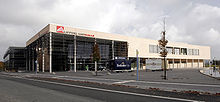
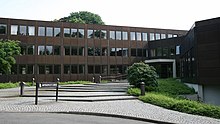
The Lippe regional association has its headquarters in Brake Castle, among other things it administers the assets of the former Free State and State of Lippe . The seat of the regional association was moved from Detmold to Lemgo, as Detmold became the seat of the new Lippe district.
The Lemgo City Library has over 50,000 media units on 1000 m².
The Lemgo Volunteer Fire Brigade has existed since 1870 . Today it comprises 7 locations in the city. 11 vehicles are stationed in the main station in Lemgo. In the districts of Kirchheide, Lüerdissen, Lieme, Hörstmar, Brake, Voßheide and Wahmbeck there are a total of 15 vehicles. 70 young people are organized in the Lemgo youth fire brigade.
The Lippe district maintains a fire brigade training center in Lemgo, which also houses the district control center for the rescue service and fire brigade. The THW has been represented in the Hanseatic city since 1952. It maintains a technical train with the drinking water supply specialist group and a youth group. Seven people from each of the two organizations are sent to the technical team of the emergency system , which, with a total of 23 helpers, is responsible for the rapid medical care of the injured in major incidents. The emergency system is used in the entire area of the Lippe district and, if requested, in the neighboring districts. The Stadtwerke Lemgo operate two thermal power stations for electricity and heat generation, wind power plants, hydroelectric power plants on the Bega, the urban bus service, the municipal parking and the leisure Eau Le.
The Phoenix Contact Arena (formerly Lipperlandhalle) is a regional sports, culture and congress center. TBV Lemgo plays the majority of its home games in the German handball league in the hall. Music and entertainment events also take place here. The Technical University of Ostwestfalen-Lippe also uses the Phoenix Contact Arena for lectures and conferences.
The municipal data center Minden-Ravensberg / Lippe (krz) , based in Lemgo, is an information and communication service provider organized as a municipal association for the three districts of Herford , Lippe and Minden-Lübbecke and most of their 36 cities and communities .
The Lemgo District Court has its seat in the city and is responsible for the cities of Bad Salzuflen and Lemgo as well as for the communities Dörentrup, Extertal , Kalletal and Leopoldshöhe . Lemgo is also the seat of a tax office.
The Klinikum Lippe GmbH maintains the Klinikum Lippe Lemgo in the city.
education
schools
In addition to the municipal primary schools in Kampstraße, Kirchheide and Südschule, there are two primary schools. The primary school association Schule am Schloss comprises the formerly independent primary schools Brake and the Ostschule. The Lemgo-West primary school association consists of the formerly independent schools Lieme and Hörstmar. There is also the private August Hermann Francke School. At all urban primary schools there are childcare offers (OGS and Reliable Primary School) sponsored by the DRK-Lippe. At the southern school, classes are taught across grades (1–3), and all-day classes are set up. The secondary schools include the Heinrich-Drake-Hauptschule, the municipal secondary school, the Engelbert-Kaempfer-Gymnasium and the Marianne-Weber-Gymnasium as well as the Karla-Raveh-Gesamtschule. Vocational schooling is provided in the Lüttfeld vocational college and the Hanse vocational college . Other facilities are the Astrid Lindgren School (special needs mental development ) in the Leese district and the Anne Frank School (special needs learning ) near the city center.
In 2014 (in comparison: 2007) the general education schools of the city with 516 (492) teachers taught a total of 6082 (6938) pupils, of which 28.0% (27.6%) in primary schools, 6.1% ( 8.2%) at the Hauptschulen and 10.9% (12.7%) at the Realschule, 27.8% (27.4%) at the Gymnasien, and 21.4% (18.3%) at the Comprehensive school and 5.8% (5.8%) at the special schools. In the Bible School Brake , theological training takes place with a qualification recognized in the free church area. With around 150 students and 27 employees, it is one of the larger evangelical- oriented training institutions in German-speaking countries. It was founded in 1959 by John Parschauer, Ernest Klassen and Heinz Weber and since then has had around 2000 graduates.
science
University
The Technical University of Ostwestfalen-Lippe (TH OWL) in Lemgo, Detmold and Höxter focuses on engineering. In addition, there are courses that are not represented elsewhere in North Rhine-Westphalia, such as the 4 Life Science Technologies faculty with courses in biotechnology, food technology, pharmaceutical technology and cosmetics and detergent technology.
research
At the TH OWL , research in the field of industrial information technology and food safety is carried out in particular . These two profile areas were funded by the state of North Rhine-Westphalia as competence platforms. The research and development center Centrum Industrial IT was built by private investors on the Innovation Campus 2009/2010 , in which around 350 experts from research institutions and high-tech companies work on new concepts of IT-based industrial automation technology under one roof. The non-university research facility Fraunhofer IOSB-INA has been located on the campus since October 2009, with its own institute building on Campusallee 1 since March 2020. The SmartFactoryOWL research factory, which opened in 2016, has created a competence center for intelligent automation.
Innovation Campus Lemgo
In 2016, a new project with great importance for the further development of the city and the surrounding area was announced with the Innovation Campus Lemgo . The aim is to create a new ecosystem for the digital economy in Ostwestfalen-Lippe, which will network existing and new actors in the university environment along the innovation chain education - research - economy. To this end, the two vocational colleges, Fraunhofer IOSB-INA , the OWL Technical University , transfer centers (such as SmartFactoryOWL) and Science2Business centers (such as Centrum Industrial IT ) will work closely together. With the Phoenix Contact Arena, a multifunctional event location is available on campus. Existing areas are to be upgraded, new places with a high quality of stay are to be created and further research institutions and companies are to be located.
Say
According to legend, the Prince-Bishop of Münster, Christoph Bernhard von Galen , besieged the fortified city of Lemgo in 1675 , but could not conquer it. The Lemgoers had become cocky and sent an ox to the bishop. On a board between the ox's horns they would have written: As little as the ox can learn to sing, Bernhard von Galen can conquer the city of Lemgo. The bishop swore by it that he wanted to destroy the city and level it to the ground and to sow oats in its place. The bishop would then drain the water of the Bega and enclose the city. Food in the city had become so scarce that there was a famine. The citizens of Lemgo should have surrendered to the bishop. The mayor and council members appeared in front of the bishop in the robe of poor sinners and pleaded for mercy. The bishop would have been moved and would have renounced the threatened vengeance. But in order to keep his oath, he would have had the pavement torn open in a city street and sown with oats. This is supposed to be the reason why the Haferstrasse still bears its name today.
Personalities
People born in Lemgo include the Enlightenment philosopher and diplomat Christian Wilhelm Dohm (1751–1820), the painter Simon Peter Tileman (1601–1688) and Engelbert Kaempfer (1651–1716), the founder of Japanese studies , after which a school in Lemgo was named, the painter, sculptor and architect Karl Junker (1850-1912), as well as the honorary citizen and Lippe politician Heinrich Drake (1881-1970), who integrated the state of Lippe into the state of North Rhine-Westphalia after the Second World War . Born in Lemgo, Karla Raveh (1927–2017) is an honorary citizen , who was deported from Lemgo as a Jew and who survived Auschwitz.
People who were not born in the city but are closely connected to Lemgo through their life, work and work: Bernhard II (around 1140–1224), Regent of the State of Lippe, Bruno Wagener-Köhler († 1988), Publishing house and newspaper owner FL Wagener Lemgo , as well as Gerhard Schröder (* 1944), Federal Chancellor from 1998 to 2005, who completed an apprenticeship as a retail salesman in Lemgo after attending elementary school .
literature
- Karl Meier : History of the city of Lemgo (= Lippe cities and villages. Volume 1; special publications of the Natural Science and Historical Association for the Land of Lippe eV Volume 9). 3rd, exp. and redesigned edition. Lemgo 1981, ISBN 3-921428-01-7 .
- City of Lemgo (= architectural and art monuments of Westphalia. 49th volume, part I). Ed. From Provinzial-Verb. the province of Westphalia. Arranged by A. Ludorff. Verl. Aschendorff, Münster 1983, ISBN 3-402-05049-8 .
- Fred Kaspar: Building and living in an old Hanseatic city. On the use of residential buildings between the 16th and 19th centuries, illustrated using the example of the city of Lemgo (= Dietrich Ellger [Hrsg.]: Preservation of monuments and research in Westphalia. Volume 9). Habelt, Bonn 1985, ISBN 3-7749-2154-7 ; (= Provinzialinstitut für Westfälische Landes- und Volksforschung, Münster [Westf.]. Folklore Commission for Westphalia: Writings of the Folklore Commission for Westphalia. Volume 28). Aschendorff, Münster 1985, ISBN 3-402-05666-6 (Zugl .: Münster [Westphalia], Univ., Diss.).
- Frido Wagener u. a. (Ed.): Memorandum on administrative reform in the Lemgo district. District of Lemgo, Der Oberkreisdirektor, Brake, Schloss 1965, DNB 450905179 .
- Gymnastics Club from 1863 e. V .: 100 years of Gymnastics Club Lemgo from 1863 e. V. Press attendant of the Lemgo gymnastics club from 1863 e. V., Lemgo 1963, DNB 452798159 .
- Friedrich Brand: Lemgo. Old Hanseatic city and modern medium-sized center. Development, analyzes, perspectives (= Westphalian geographic studies. Volume 45). Edited by the Geographical Commission for Westphalia. Geographical Commission for Westphalia, Münster 1992, DNB 931223539 .
- Peter Johanek, Herbert Stöwer (Hrsg.): 800 years of Lemgo: Aspects of city history (= contributions to the history of the city of Lemgo. Volume 2). Wagener, Herford 1990, ISBN 3-921428-55-6 .
- Roland Linde: Lemgo in the time of the Hanseatic League. The history of the town 1190–1617. Edited by the Alt-Lemgo e. V. Spethmann, Lemgo 2015, ISBN 978-3-9802737-5-6 .
- Heinz Stoob: Westphalian city atlas. Volume II, Part 8. On behalf of the Historical Commission for Westphalia and with the support of the Regional Association of Westphalia-Lippe, ed. by Heinz Stoob and Wilfried Ehbrecht. City map Lemgo. Dortmund / Altenbeken 1981, ISBN 3-89115-351-1 .
Documentation
- Hexenwahn in Lemgo - The witch hunt and the witch mayor's house. Documentation of the LWL media center for Westphalia, director: Andrea Konschake, Germany 2007, approx. 25 min .; Movie description. In: LWL media center for Westphalia: materials for regional and cultural education. A media selection. Münster 2014, p. 11 ( PDF; 385 kB ); Press release. In: lwl.org. August 27, 2007, accessed on December 29, 2016 (also for the making-of ).
Web links
|
Further content in the sister projects of Wikipedia:
|
||
|
|
Commons | - multimedia content |
|
|
Wiktionary | - Dictionary entries |
|
|
Wikisource | - Sources and full texts |
|
|
Wikinews | - News |
|
|
Wikivoyage | - Travel Guide |
- City of Lemgo
- Walking tour through the old town of Lemgo (article)
- Lemgo for children:
- The city of Lemgo. (No longer available online.) In: kinder-lippe.de. Lippischer Heimatbund , archived from the original on May 18, 2007 (on the history of the city; source: Homepage of the city of Lemgo www.lemgo.de).
- Bernhard zur Lippe founds Lemgo. (No longer available online.) In: kinder-lippe.de. Lippischer Heimatbund, archived from the original on May 14, 2006 (from: Our Lippische Heimat. A reading and workbook for the elementary schools in the Detmold and Lemgo districts. Ed. By the General Lippische Lehrerverein. 2nd, revised edition. 1967, p. 27-29).
- Link catalog on Lemgo at curlie.org (formerly DMOZ )
- Lemgo in the OpenStreetMap project
- Lemgo | Lippe News - Portal with information about the city of Lemgo
- Lemgo in the Westphalia Culture Atlas
- House inscriptions in Lemgo
Footnotes
Remarks
- ↑ In the Frenkelhaus you can see a permanent exhibition on the history of the Jews in Lemgo.
Individual evidence
- ↑ Population of the municipalities of North Rhine-Westphalia on December 31, 2019 - update of the population based on the census of May 9, 2011. State Office for Information and Technology North Rhine-Westphalia (IT.NRW), accessed on June 17, 2020 . ( Help on this )
- ↑ City portrait of the project “Reformation cities of Europe”: Reformation city of Lemgo. Germany. A "two-class society". In: reformation-cities.org/cities, accessed on November 18, 2016. For information on the importance of Lemgo in the history of the Reformation, see the sections Reformation and the persecution of witches and religions as well as the city portrait of the project “European Station Path”: Lemgo. Detmold / Lemgo - Free together. In: r2017.org/europaeischer-stationweg, accessed on November 18, 2016.
- ↑ Statistical information. In: lemgo.net. Old Hanseatic City of Lemgo, accessed on July 15, 2017.
- ↑ Geological Service NRW: Geoscientific Community Description Lemgo. (No longer available online.) In: gd.nrw.de. 2004, archived from the original on July 28, 2014 ; accessed on February 10, 2019 .
- ↑ Geological Service NRW: Using geothermal energy: Geothermal study provides planning basis. (PDF; 369 kB) (No longer available online.) In: gd.nrw.de. August 4, 2005, archived from the original on March 26, 2015 ; accessed on February 10, 2019 .
- ↑ State database NRW: municipal profile Lemgo, city. (PDF; 222 kB) (No longer available online.) In: it.nrw.de. December 10, 2014, p. 3 , archived from the original on May 1, 2015 ; accessed on February 10, 2019 (area on December 31, 2013 by type of use).
- ^ A b Martin Bünermann: The municipalities of the 1st reorganization program in North Rhine-Westphalia . A manual for the local reorganization with systematic overviews and lists of the new and the dissolved communities (= Kommunale Schriften für Nordrhein-Westfalen . Volume 32 ). Deutscher Gemeindeverlag, Cologne 1970, DNB 456219528 , p. 68, 106 .
- ↑ Main statutes of the old Hanseatic city of Lemgo from October 26, 2010. (PDF; 669 kB) (No longer available online.) In: lemgo.net. Archived from the original on June 24, 2016 ; Retrieved on February 10, 2019 (as of March 2, 2017.).
- ↑ residents of the districts. (No longer available online.) In: lemgo.net. City of Lemgo, November 18, 2016, archived from the original on October 16, 2013 ; accessed on February 10, 2019 .
- ↑ a b Old Hanseatic City of Lemgo - Population Statistics. (No longer available online.) Old Hanseatic City of Lemgo, formerly in the original ; accessed on October 7, 2017 (no mementos ). ( Page no longer available , search in web archives )
- ↑ Climate maps. Annual mean temperature in ° C. (No longer available online.) In: stadtdetmold.de. March 24, 2016, archived from the original on March 24, 2016 ; accessed on February 10, 2019 : "From: Climate atlas NRW (map excerpts)"
- ^ A b Charlemagne as possible forefather of Lemgo. In: Lippische Landes-Zeitung. November 19, 2009.
- ↑ Otto Preuß , August Falkmann (arrangement): Lippische Regesten. 4 vol., Detmold / Lemgo 1860–1868, here: Volume 1: From the year 783 to the year 1300. Meyer, Lemgo / Detmold 1860, OCLC 753077880 , p. 58: No. 13 (July 20, 1005: Lingauwe ); P. 59: No. 16 (April 10, 1011: Limga ); P. 83: No. 62 (1149: Limego ) ( facsimile ). In: archive.org, accessed December 29, 2016.
- ↑ Trade routes from Herford to Hameln (west-east) and from Rinteln via Detmold to Paderborn (north-south).
- ^ Karl Meier-Lemgo : History of the city of Lemgo. Verlag F. L. Wagener, Lemgo 1952, DNB 453287891 , page 10 ff .; 3rd, exp. and newly designed edition (= Lippe cities and villages. Volume 1; special publications of the Natural Science and Historical Association for the Land of Lippe eV Volume 9), ibid 1981, ISBN 3-921428-01-7 .
- ↑ a b c d Lippe. 24 tables (= regional studies of North Rhine-Westphalia ). On behalf of the Lippischen Heimatbund ed. by Wilhelm Rinne. Greeting from Johannes Rau . Foreword by Walter Stich . Contribution by Jürgen Baral u. a. Rheinland-Verlag, Cologne; Verlag Ferdinand Schöningh, Paderborn 1993, ISBN 3-506-76111-0 , p. 289 ff.
- ↑ F.-W. Hemann: Lemgo . In: Lexicon of the Middle Ages (LexMA). Volume 5, Artemis & Winkler, Munich / Zurich 1991, ISBN 3-7608-8905-0 , Sp. 1870.
- ^ Letter from the Lemgo City Council on the resolution of June 18, 2012 on the rehabilitation of the victims of the witch trials in Lemgo (PDF; 865 kB). In: anton-praetorius.de, accessed on November 19, 2016.
- ↑ Jürgen Scheffler: 200 Years of Leinenkracht - For the exhibition in the Museum Hexenbürgermeisterhaus. In: Heimatland Lippe. Journal of the Lippischen Heimatbund and the Landesverband Lippe. May / June 2010.
- ^ Karl Heinz Jahnke: Resistance in Lemgo. In: hiergeblieben.de. Study Group German Resistance 1933–1945 e. V. November 1, 2000, accessed on November 19, 2016 (notes on the biography of Willy Langenberg).
- ^ Letter from the mayor / local police authority to the secret state police station in Bielefeld from November 17, 1938. In: Volkshochschule Lemgo: Lemgo in the 3rd Reich, report and collection of materials. n.d., pp. 115-117.
- ↑ a b Script: Persecuted people during the Nazi era and their family members (persecution for racist reasons), Lemgo City Archives, version from January 27, 2012.
- ↑ Volker Wehrmann (Ed.): Lippe in the Third Reich. The education for National Socialism. Documentation from 1933–1939. Edited by the Documentation Center for Regional Cultural and School History at the Faculty of Education at Bielefeld University. Documentation center for regional cultural and school history at Bielefeld University, Detmold 1984, pp. 158, 165; 2nd Edition. 1987, DNB 880970995 .
- ↑ Memorial Book. Search in the name directory. Search for: Lemgo - residence. In: bundesarchiv.de, last accessed on July 8, 2020.
- ↑ See The End of the War in Lippe. In: Andreas Ruppert, Hansjörg Riechert: Domination and acceptance. National Socialism in Lippe during the war years. Analysis and documentation (= publications of the State Archives of the State of North Rhine-Westphalia. Series C: Sources and Research. Volume 41). VS Verlag für Sozialwissenschaften, Wiesbaden 1998, ISBN 3-663-10299-8 , pp. 243–246, here: p. 243 note 2 (preview in: doi : 10.1007 / 978-3-663-10298-4_6 [“ Click “Look inside”; download with costs]); Reprinted there in 2013, ISBN 978-3-663-10299-1 .
- ↑ Karl Schölpert: cityscape care and preservation of historic buildings. In: Heimatland Lippe. Edited by Lippischer Heimatbund e. V. June / July 2000, ISSN 0017-9787 , pp. 160-164 ( digital-sammlungen.llb-detmold.de ).
- ↑ Hochschule OWL is one of the ten strongest research universities in Germany. Retrieved July 29, 2020 .
- ↑ Martin Bünermann, Heinz Köstering: The communities and districts after the municipal territorial reform in North Rhine-Westphalia . Deutscher Gemeindeverlag, Cologne 1975, ISBN 3-555-30092-X .
- ^ State statistical office of North Rhine-Westphalia: Municipal statistics of the state of North Rhine-Westphalia. [Part 4]: Population development 1816–1871 (= contributions to the statistics of the state of North Rhine-Westphalia. Special series of the population census [year] 1961. H. 3d). Düsseldorf 1966, DNB 456717854 , p. 217.
- ^ State statistical office of North Rhine-Westphalia: Municipal statistics of the state of North Rhine-Westphalia. [Part 3]: Population development 1871–1961 (= contributions to the statistics of the state of North Rhine-Westphalia: special series of the population census [Bg.] 1961. H. 3c). Düsseldorf 1964, DNB 456717846 , pp. 396-397.
- ^ State Statistical Office of North Rhine-Westphalia: The resident population in the municipalities of North Rhine-Westphalia 1970. Results of the census on May 27, 1970 (= contributions to the statistics of the State of North Rhine-Westphalia. H. 1). Düsseldorf 1972, DNB 730463745 , p. 41.
- ^ State Office for Data Processing and Statistics North Rhine-Westphalia: Special series on the 1987 population census in North Rhine-Westphalia, Volume 1.1: Population, private households and employed persons . Düsseldorf 1989, DNB 901164909 , p. 110.
- ^ State Office for Data Processing and Statistics North Rhine-Westphalia: State database North Rhine-Westphalia. In: nrw.de, accessed on November 19, 2016.
- ↑ Numbers, data, facts. Population. In: lemgo.de, 2020, accessed on July 8, 2020.
- ^ Christian Kuhnke: Reformation. In: Ders .: Lippe Lexikon. Places, people, landscapes, history, sights, companies. Boken Verlag, Detmold 2000, ISBN 3-935454-00-7 .
- ↑ From a press release by the State Office for Information and Technology in North Rhine-Westphalia from 2004: Pupils at general schools in North Rhine-Westphalia according to religious affiliation.
- ↑ Election results of the municipal code 05,766,044th Landesdatenbank NRW.
- ↑ State Office for Information and Technology in North Rhine-Westphalia: local elections. In: nrw.de, accessed on November 19, 2016.
- ↑ European elections / municipal elections 2014. In: wahl.krz.de, accessed on November 19, 2016.
- ↑ Homepage of the GfL. In: lemgo.ratsinfomanagement.net. November 19, 2016, accessed February 10, 2019 .
- ^ City of Lemgo: Mayor. In: lemgo.net, accessed on November 19, 2016 (with representatives).
- ↑ § 1, Paragraph 2 of the Main Statute of the Old Hanseatic City of Lemgo from October 26, 2010 ( Memento from October 8, 2017 in the Internet Archive ). (PDF; 669 kB) as of March 2, 2017.
- ^ Statistics office of the Lippe district. In : kreis-lippe.de, accessed on July 8, 2020 (illustration).
- ^ City of Lemgo: partnership with Vandœuvre-lès-Nancy. In: lemgo.net, accessed November 19, 2016.
- ^ City of Lemgo: partnership with Beverley. In: lemgo.net, accessed November 19, 2016.
- ^ City of Lemgo: partnership with Stendal. In: lemgo.net, accessed November 19, 2016.
- ↑ Article. In: reisereporter.de, accessed December 28, 2017.
- ↑ Press release: Where is the most beautiful town hall in North Rhine-Westphalia? Retrieved May 10, 2020
- ↑ Roland Linde: Lemgo in the time of the Hanseatic League. The history of the town 1190–1617. Edited by the Alt-Lemgo e. V. Spethmann, Lemgo 2015, ISBN 978-3-9802737-5-6 , p. 72 f.
- ^ Regional Association Westphalia-Lippe: Wall systems Lemgo in LWL GeodatenKultur.
- ^ Regional Association Westphalia-Lippe: Abbey Garden Lemgo in LWL GeodatenKultur.
- ↑ STAFF landscape park. (No longer available online.) In: staffstiftung.de. November 19, 2016, archived from the original on March 9, 2016 ; accessed on February 10, 2019 .
- ↑ Landschaftsverband Westfalen-Lippe: Staff Landschaftspark in LWL-GeodatenKultur.
- ↑ On Johannisstein research see Erich Neumann: Johannissteine bei Lage - a (pre-) early historical calendar system (continuation). In: Heimatland Lippe. 77th year. No. 1, January 1984 ( johannissteinforschung-lage.de ), accessed on November 19, 2016.
- ^ "Begatal" nature reserve in the specialist information system of the State Office for Nature, Environment and Consumer Protection in North Rhine-Westphalia , accessed on February 25, 2017.
- ↑ "Hardisser Moor" nature reserve in the specialist information system of the State Office for Nature, Environment and Consumer Protection in North Rhine-Westphalia , accessed on February 25, 2017.
- ^ Lipper Sagittarius. Internet presence of the Schöttker company. In: schoettker-lemgo.de. Retrieved February 10, 2019 .
- ↑ Fraunhofer real laboratory Lemgo Digital. Retrieved July 15, 2018 .
- ↑ Query of the course book route 404 at Deutsche Bahn.
- ↑ See u. a .: Adolf Müller-Hellmann (Red.): City bus - being mobile in small and medium-sized towns (= Association of German Transport Companies: VDV-Förderkreis e.V. [Ed.]: Blue Book Series of the VDV . Volume 6 ). Alba Fachverlag, Düsseldorf 2000, ISBN 3-87094-642-3 , p. 92 ff .
- ^ LDS NRW : Airline distance of the municipalities to airport central points, for Hanover. In: geodatenzentrum.de, accessed on November 19, 2016.
- ↑ City of Lemgo: Lemgo - strong business location at the top of OWL. In: lemgo.de. Retrieved on February 10, 2019 (with map of the area).
- ↑ Law on the reorganization of the municipalities and districts of the Bielefeld reorganization area (Bielefeld law) of October 24, 1972. (PDF; 314 kB) Area change agreement between the districts of Detmold and Lemgo as an annex to the Bielefeld law. In: bielefeld.de. September 30, 2016. Retrieved November 19, 2016.
- ↑ Signpost. (PDF; 244 kB) City administration brochure. (No longer available online.) In: lemgo.de. October 2016, archived from the original on November 22, 2016 ; accessed on February 10, 2019 .
- ^ Municipal profile Lemgo, city. (PDF; 222 kB) (No longer available online.) In: it.nrw.de. State Office for Data Processing and Statistics North Rhine-Westphalia, December 10, 2014, p. 13 , archived from the original on May 1, 2015 ; accessed on February 10, 2019 (as of December 10, 2014).
- ↑ CENTRUM INDUSTRIAL IT (CIIT) - About the CIIT. Retrieved March 15, 2018 .
- ^ Website Innovation Campus Lemgo, accessed on November 19, 2016.
- ^ The Haferstrasse in Lemgo. In: kinder-lippe.de. Lippischer Heimatbund e. V., accessed on February 10, 2019.

